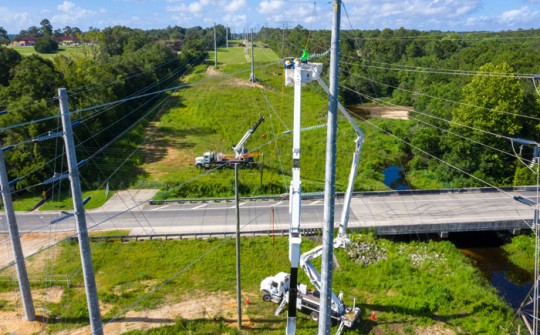Gulf Power Transmission Projects Underway To Improve Reliability
September 7, 2020
Gulf Power is continuing to strengthen the grid to improve reliability in both good weather and bad with a major project on a transmission power line in Escambia County.
The transmission project kicked off at the beginning of the year by replacing wooden poles with 25 concrete poles over an eight-mile stretch of transmission lines located near Gulf Power’s Plant Crist. This summer, the second phase of the project began, which will increase the capacity of the line as well as replace wooden poles with 70 concrete poles. The new concrete poles are 100 to 140 feet tall / up to four feet wide and are built to withstand winds of up to 140 mph.
“As part of the Florida Power & Light family, we’re committed to improving reliability – which is already the best it has been – in both good weather and bad for our customers,” said Mike Spoor, vice president of power delivery for Gulf Power. “We know how important reliable service is for our customers, especially during this time, and we’re continuing to invest in hardening and other upgrades that will make our electric system stronger and more resilient during hurricane season.”
This project is upgrading a section of transmission line that comes out of Gulf Power’s Plant Crist, which is currently undergoing a modernization to convert from coal as its main fuel source to cleaner, lower-cost natural gas. When complete, the Plant Crist modernization will lower carbon emissions at the site by an estimated 40%.
The transmission upgrade project is part of Gulf Power’s plan to spend approximately $600 million through 2022 in capital investments to improve reliability, bring cleaner energy to Northwest Florida and enhance service for customers.
Gulf Power has already upgraded more than 170 wooden transmission structures to concrete or steel, with more planned for replacement in the coming years. Other storm hardening and reliability improvement projects include regular vegetation management trimming cycles, using drones to inspect lines to detect possible issues before they occur and the installation of automated lateral switches to isolate outages and restore power more quickly.
Comments
5 Responses to “Gulf Power Transmission Projects Underway To Improve Reliability”




REGARDING:
“any step in the direction of moving all utilities underground would be better.”
It helps to remember that around here, “underground” also means “underwater” much of the time.
Undergrounding High Voltage Lines would be very expensive and would present a completely different set of problems for maintenance in being able to spot where a problem is located in the line.
Having high voltage lines in the same ditch would likely lead to heat issues that over time would affect insulation and likely many other maintenance issues that I’m not qualified to understand or explain.
Having the lower high voltage lines in neighborhoods for lateral line installations to residential service is less problematic and probably a good idea except that in order to do it, it seems all trees and root systems have to be removed which is probably the biggest part of the threat to overhead power lines during a storm so it comes down to esthetics and is it cost effective to run electricity along the roads mixed underground with water, sewer, storm drains and gas?
Earlier comments might want to research cost of locating transmission lines underground if you want to be a customer to be a part of footing the cost for that bill be my guest!
Personally I believe that any step in the direction of moving all utilities underground would be better. The upgraded poles are an eyesore, not to mention the amount of space required as well as above ground lines still far more vulnerable to damage in the event of a hurricane. I agree with Kate, regardless of the cost we, the consumer, will cover it in the end.
Underground system makes a lot more sense and will cost less in the end. They always assure we cover the cost for their errors in judgement.